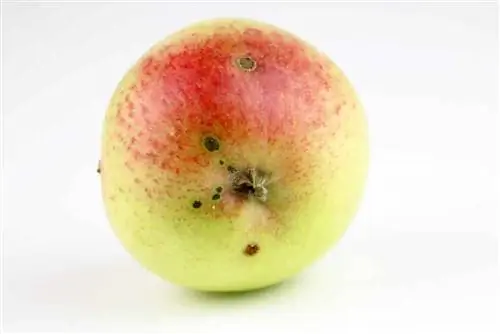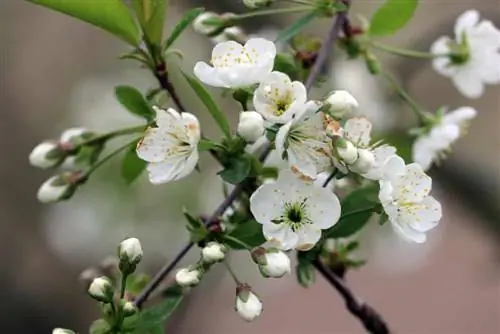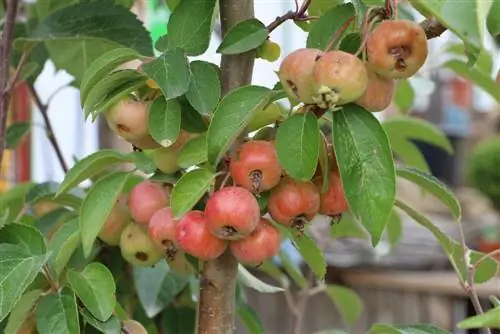- Author admin [email protected].
- Public 2023-12-17 03:39.
- Last modified 2025-06-01 06:48.
Beautiful flowers and delicious fruits - the apple tree has a very special tradition in our latitudes. However, after many years of rich harvest, the fruits become smaller and perhaps even more sour.
So that the apple tree stays in shape and the harvest is productive and continues to taste delicious, the rejuvenation cut provides a recovery treatment - for the wood and fruits of the apple tree.
The important cut for the apple tree
Spindle trees or columnar fruit - which particularly include newer varieties - grow neither tall nor particularly wide. The size and shape of well-behaved apple trees simplify planting and harvesting. When planting, the apple trees are shaped with a cutting that determines their future shape. The aim of planting pruning is to achieve an even crown structure and a consistently good harvest. After the apple tree has been planted, further types of pruning are required for regular care. In order to keep the classic apple tree young and fit, it must be regularly thinned and pruned in the following years. Regular tree pruning ensures a consistently good apple harvest - year after year. The rejuvenation or maintenance pruning makes the apple tree
- more resilient,
- increases lifespan,
- improves nutrient distribution in the tree,
- also allows the lower branches to receive more light and
- ultimately leads to a more productive and higher quality harvest.
The right types of pruning for the apple tree
When fruit trees are successfully pruned, old shoots and dead wood are first removed. With the next shoot, the fruit tree pruning shows the visible success of the pruning: more abundant blossoms are followed by a richer harvest with improved fruit quality. However, the young apple tree must be trained so that an even and well-branched crown is formed.
After the first planting cut, the branches growing steeply upwards are tied down with the training cut, provided they compete with the main shoot (run parallel). If the branches are already too strong, they are cut off directly on the branch. If they remain on the tree, there is a risk that a so-called double crown will form over the years, meaning that only little light will fall into the tree. In addition, a double crown also leads to instability of the tree.
During the subsequent training pruning, the central shoot and the side shoots are shortened slightly to promote the growth of the tree. The subsequent pruning of the young apple tree next autumn requires further pruning, which enables good branching and the growth of a spindle-shaped crown.

When pruning, the side shoots that grow steeply upwards are also removed and long, unbranched shoots are shortened in order to promote the growth of the fruit-bearing branches. Shoots that lean strongly downwards or grow into the interior of the crown are removed when pruning.
Apple tree rejuvenation treatment
After five fruitful years, the shape and crown structure of the apple tree are complete. From this point on, the gardener ensures that the apple tree maintains its fertility. With increasing growth, strong branches and thick foliage, the incidence of light on the fruit in the tree must be kept high and even. Regular maintenance pruning ensures the annual rejuvenation of the apple tree and ensures a regular and consistent harvest. With the maintenance cut:
- the construction of the tree's stable support frame is supported
- promoted the highest possible amount of fruit on the shoots, which also have to withstand increased snow pressure
- Higher fruit quality achieved through better exposure of the tree shoots
- Proper pruning of the apple tree promotes an earlier harvest
- extends the lifespan of the apple tree and maintains its performance
- Harvest fluctuations mitigated.
Achieve new vitality with the rejuvenation cut
Thinning out the crown area and removing old wood are among the main tasks of conservation pruning. The incidence of sunlight is increased and also enables a good harvest on low-hanging branches. The shoots that grow steeply upwards into the interior of the crown must be completely removed during maintenance or rejuvenation pruning. Old wood, which is characterized by strong branches, hardly bears any fruit and is cut back to a younger and more vital side branch during maintenance pruning.
The“Pruning Laws” for the apple tree:
- strong pruning leads to strong budding
- weak pruning causes weak shoots
- uneven pruning promotes uneven budding.
Cones or so-called “coat hooks” are not left standing when pruning. If old or excess wood is cut back, the cut is made - with a sharp tool - directly on the trunk. It is important for the gardener to first determine the leading branches and the center of the tree. Afterwards, the shortening or forwarding to cheaper extensions (with competing side shoots) can take place. Thinning out the crown is also crucial for a bountiful harvest.
Pruning the apple tree: what is the right time?
As a rule of thumb, the stronger the apple tree's growth, the later it should be cut. A late pruning date inhibits the growth of the fruit tree, but at the same time promotes the growth of fruitful short shoots. It is therefore advisable to cut strong-growing trees in spring and spindle trees - the slow-growing varieties of apple trees - in late autumn, after the harvest.
Fruit trees reach a great age, which can be extended even further with rejuvenation pruning. In particular, the rejuvenation of the apple tree through targeted pruning and the removal of old wood ensures a more productive harvest and improved fruit quality. The maintenance or rejuvenation pruning, which should be done for the first time after about five years, is part of the apple tree's annual care and rewards with new growth, a more resilient tree and a consistent harvest. With a little practice, even the hobby gardener can recognize annoying shoots that inhibit growth. Every rejuvenation cut of the apple tree - even if it is not perfect - awakens its spirit.
What you should know about pruning apple trees in brief
The apple tree is not only a perfect source of shade, but also ideal for getting your own fruit from your home garden. But in order for older apple trees in particular to still feel comfortable and remain productive, they have to be cut back and traded again and again. It is important to proceed correctly so that the old apple tree actually recovers through the cut and does not suffer any damage in the end.
- With older apple trees you have to concentrate especially on the tree crown. After the many years that the apple tree has already passed, this is certainly very dense and therefore needs to be thinned out again.
- This is so important because a closed treetop does not provide enough sunlight for the apples and the tree is therefore no longer particularly fruitful.
- But you can change this very easily: old branches are removed, as are the shoots growing upwards and into the interior of the crown.
- Especially where there are many branches, one can assume that these are particularly old and no longer usable branches.
- This needs to be cut back to a younger side branch and thus create more space so that the sun can shine better through the branches and cover all areas of the apple tree again.
Of course, the fruit tree pruning described here only makes the most sense if it is carried out taking into account the most suitable time, which is shortly after the harvest. If the old apple tree is then cut back according to the explanations, you can look forward to rich yields again next year and have the positive side effect that the apple tree is visually in better shape again.
The general rule for an apple tree is: the larger it is and the stronger it grows, the later the date for pruning should be chosen so that as many fruitful shoots as possible can develop.






